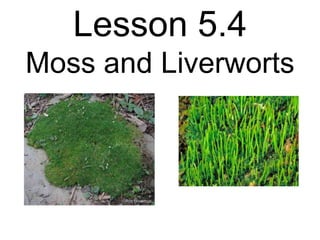
Biology Lessons 5.4 and 5.5
- 1. Lesson 5.4 Moss and Liverworts
- 8. Lesson 5.4 Moss and Liverworts Characteristics of moss: Nonvascular therefore have no true roots, leaves or stems Called bryophytes Grow in shade and moist environments Grow low to ground as ground cover Have rhizoids that anchor the plant
- 9. Lesson 5.4 Moss and Liverworts Characteristics of moss: Rhizoid - thread-like hairs that grow down into soil Benefits of moss: Replenish soil by chemical weathering Prevent soil erosion
- 10. Lesson 5.4 Moss and Liverworts Economic importance: Sphagnum – grows in swamps, cells hold water. Peat Moss/Peat - decaying plant material trapped in bottom of a swamp and in US is sold to mix with soil to increase moisture retention and enrich the soil.
- 11. Lesson 5.4 Moss and Liverworts Spanish moss is called a moss but is really an angiosperm.
- 12. Lesson 5.4 Moss and Liverworts Life Cycle of Moss Has alternating generations: A. Sporophyte generation Produced on top of female plant and produces spores after fertilization Spores are released and become gametophyte plants
- 13. Lesson 5.4 Moss and Liverworts Life Cycle of Moss Has alternating generations: A. Sporophyte generation B. Gametophyte generation Produces egg and sperm cells Sperm cells must swim to egg cell Results in fertilization and formation of sporophytes plant
- 16. Lesson 5.4 Moss and Liverworts Liverworts Characteristics: Bryophytes No true leaves, stems or roots Have rhizoids Grow in moister places than moss Reproductive structures look like umbrellas
- 17. Lesson 5.5 Algae
- 18. Lesson 5.5 Algae Characteristics Belong to kingdom Protista Most contain chlorophyll Most small in size Lack stem, roots, or leaves Most live in water Important the food chain because compose most of plankton
- 19. Lesson 5.5 Algae Characteristics Important the food chain because compose most of plankton Plankton - the collection of small or microscopic organisms that float or drift in great numbers in fresh or salt water, especially at or near the surface, and serve as food for fish and other larger organisms. Classified by color
- 20. Lesson 5.5 Algae Classification A. Green Algae o Largest group o Green o Mostly microscopic, single celled o Some live in colonies o Some filamentous, have filaments to attach to rocks o freshwater
- 21. Green Algae
- 22. Lesson 5.5 Algae Classified by color B. Yellow algae oContains yellow pigment oPhotosynthetic – chlorophyll too oIncludes diatoms (two part silica shell) oCollection of empty shells makes diatomaceous earth used in toothpaste, scrubbing products, filters & dynamite to stabilize
- 23. Diatoms
- 24. Lesson 5.5 Algae Classified by color C. Brown algae obrown pigment oPhotosynthetic – chlorophyll too oMostly seaweed including the giant kelps that live in the ocean oAlgin from kelp used in food products to hold liquids together like in mayonnaise
- 25. Brown algae – Giant Kelp
- 26. Lesson 5.5 Algae Classified by color D. Red algae oFound in great depths in the ocean oCan trap wavelengths of light that travel deep into water and use for photosynthesis oContain carrageenin used to thicken products like ice cream and nutrient agar
- 28. Lesson 5.5 Other Algae: A. Dinoflagellates •Microscopic algae •Have two flagella •Cause red tides which is when extreme growth or blooms creating a toxin that can kill fish
- 30. Lesson 5.5 Algae B. Cyanobacteria or blue-green algae •Originally classified as algae now as bacteria •Many have a bluish appearance •Great survival in adverse conditions
